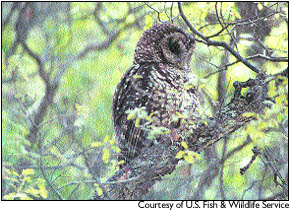|
April 5, 2001
By Tom Sluis A group of conservationists says it will sue the U.S. Fish and Wildlife Service for excluding 9 million acres in the Southwest — including Mesa Verde National Park and the San Juan National Forest — as critical habitat for the endangered Mexican spotted owl. The action comes on the heels of a Jan. 16 decision by the Fish and Wildlife Service to designate 4.6 million acres of land that may require special management for the endangered bird under the Endangered Species Act. The problem, say the Boulder-based Center for Native Ecosystems, Durango-based Colorado Wild and Center for Biological Diversity in Tucson, is that Fish and Wildlife Service improperly excluded many areas where the owl is known to exist or has existed historically. "The Fish and Wildlife Service is refusing to protect all the key habitat in Colorado," said Jacob Smith, conservation director for the Center for Native Ecosystems. "They didn’t even include all the places we know the spotted owl lives."
The Center for Biological Diversity said 90 percent of the known owls live in national forests in Arizona and New Mexico, but no acres in these forests were designated as critical habitat. Elizabeth Slown, spokeswoman for the Fish and Wildlife Service, said the lawsuit was not unexpected, but withheld comment because she has not seen the lawsuit. The agency, which administers the Endangered Species Act, had originally targeted 13.5 million acres in its draft proposal for protection. But by the final draft it reversed course and excluded federal lands under the jurisdiction of other agencies that have agreed to implement conservation measures that protect the owl. Smith said deferring responsibility to other agencies does not meet the legal or biological requirements of the Endan-gered Species Act. He said the recovery plans were not fully incorporated into the forest plans, parts were incorporated, but not monitored, and the forest plans are up for revision over the next few years. "There is no guarantee that the recovery provisions will be incorporated into those plans," Smith said. The owl was listed as threatened under the Endangered Species Act in 1993, when the population was estimated at 2,160. Smith, with the Center for Native Ecosystems, said the number has not been updated. The owl’s range extends from the southern Rocky Mountains in Colorado and the Colorado Plateau in Utah southward through Arizona and New Mexico into the Sierra Madres in Mexico. Heavy logging and the resultant habitat degradation in Arizona and New Mexico was the primary factor necessitating listing. Whether the bird can still be found in Southwest Colorado is up to debate. Marilyn Colyer, the natural-resources supervisor of biotech at Mesa Verde National Park, said there was no record of the medium-sized bird at the park last year, but that the park has records of breeding pairs going back to 1948. "There are probably still some here," Colyer said, but last year the park may have missed the birds because no one was available to look for them, she said. Barry Rhea, of Rhea Environmental Consulting in Durango, was hired by the San Juan National Forest in the 1980s to see if the bird could be found. Over four years no owls were identified, he said. "It probably has to do with the fact that the San Juan National Forest, elevation-wise, is a little bit above the spotted owl’s normal habitat," Rhea said. "The snow persists well into the breeding season, making it difficult for the owls to find a prey base to support the nestlings." Rhea said that once while he was on a different job he heard a spotted owl near Ignacio Creek, which is a tributary to Stollsteimer Creek east of Bayfield, but Fish and Wildlife Service was not able to find the bird later. Smith, with the Center for Biological Diversity, said whether the bird can be found in potential habitat is missing the point. "The species will not recover in the current isolated pockets they are in," Smith said. "The extra area is needed for their expansion and for their numbers to increase. "The small remaining populations are doomed to extinction unless they have connectivity to a larger population." Rocky Smith, Colorado Wild’s forest watch coordinator, said designating critical habitat is making amends for the past. "The spotted owl faces extinction because we have systematically destroyed and fragmented the old forests in which it lives," Smith said. Under the Endangered Species Act, a 60-day notice to sue is required. Smith, with the Center for Biological Diversity, said the lawsuit has not been filed yet. Critical-habitat designation does not set up a preserve or refuge, and does not apply to private, state or tribal lands. The designation includes 830,000 acres in Arizona, 525,000 acres in Colorado — in the Pike-San Isabel National Forest and the Royal Gorge Resource Area — 54,000 acres in New Mexico and 3.2 million acres in Utah. The Fish and Wildlife Service does not expect the designation to affect thinning necessary to reduce wildfire fuels, collecting wood for personal use, or Christmas-tree-cutting. It also is not expected to affect livestock-grazing and most recreation activities including hiking, camping, fishing, hunting, cross-country skiing, off-road-vehicle use and various wildlife-observation activities. |
||||
|
Copyright © 2001 the Cortez Journal.
All rights reserved. |
